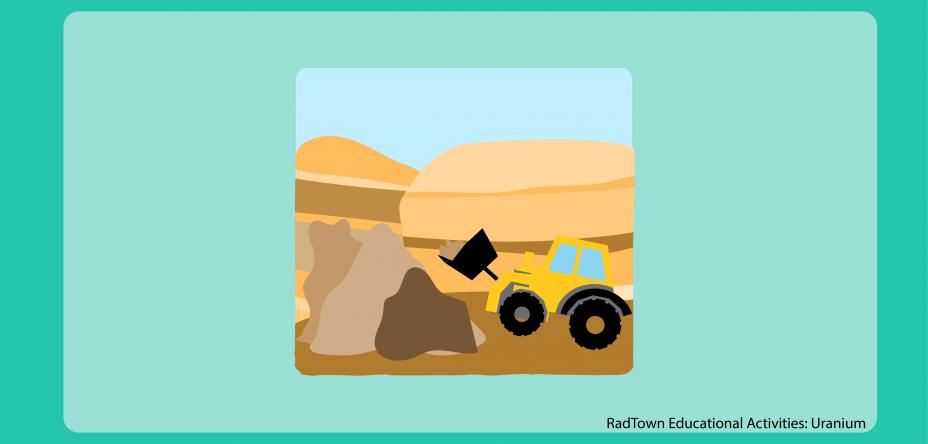Uranium has been used for hundreds of years, first as a dye or pigment and more recently, as a fuel for nuclear power plants. But what is uranium, and how does it connect with radon gas and radium? Learn more about the uranium decay chain and atomic structure of uranium, radium, and radon in this activity. This activity is intended for middle and high school students.
- Objectives
- Next Generation Science Standards
- Materials and Resources
- Time
- Vocabulary
- Directions
- Common Core State Standards
- Printable Worksheets and Classroom Aids
Objectives
Students will:
- Determine the atomic structures of uranium, radium and radon.
- Describe the characteristics of each.
- Examine the benefits and risks of each.
NOTE: Students should have a basic understanding of the periodic table and how to determine the atomic structure of elements.
Next Generation Science Standards
The concepts in this activity can be used to support the following science standards:
- PS1. Structure and Properties of Matter
- ESS3. Earth and Human Activity
Materials and Resources
Each italicized document title can be found at the bottom of this page, and is available for printing and distribution.
- Uranium: Teacher Background Information
- Vocabulary Materials
- Uranium Past and Present images (one per student, pair or group or display with a computer and projector)
- Uranium, Radium and Radon Worksheet (one per student, pair or group) and Uranium, Radium and Radon Teacher Answer Key
- Periodic Table of Elements (one per student, pair or group)
- Student computers with Internet access or provide print versions for students (optional):
Time
45-60 minutes, not including optional activities or extensions.
Vocabulary
- Atom
- Electron
- Neutron
- Nuclear energy
- Proton
- Radiation
- Radioactive atom
- Radioactive decay
- Radium
- Radon
- Uranium
- Uranium mining
Directions
- Start with a vocabulary activity if students are not familiar with uranium and the vocabulary used in this activity.
- Share the Uranium Past and Present images. Explain that a uranium mining boom took place in the U.S. from the mid-1940s to 1970s. During this period thousands of uranium mines were in operation, primarily in the Western part of the U.S.
- Ask students why uranium was mined and how it is used today. Uranium was mined primarily for the development of nuclear weapons and then for power generation. The images show the industrial uses today include:
- A nuclear power plant: Nuclear power plants produce electricity through a heat- generating process known as "fission" in which neutrons split uranium atoms to produce large amounts of energy.
- A nuclear-powered supercarrier: A small nuclear reactor powers submarines, supercarriers, icebreakers and other ships. In the defense industry, depleted uranium metal is used for armor plating and armor-piercing projectiles.
- Distribute the Uranium, Radium and Radon Worksheet. Direct students to use the Periodic Table of Elements to complete the activity. The atomic number will provide students with the number of protons and electrons. They can calculate the neutrons by subtracting the atomic number from the atomic mass. Resources may include information from the Environmental Protection Agency (EPA) webpages listed in the Materials and Resources section.
- Review student responses as a class using the Uranium, Radium and Radon: Teacher Answer Key. Conclude by asking students to share at least one thing they learned about uranium, radium or radon.
- Optional activities or extensions: Have students examine:
- The atomic structure and physical characteristics of each element.
- The types of radiation each emits (alpha particles, beta particles and gamma rays), the potential exposure pathways (direct exposure, ingestion and inhalation), the potential health effects and the potential protection measures people can take to avoid exposure to these elements. Information about uranium, radium and radon can be found on Radionuclides.
- Explore how the uranium to lead decay chain can be used in radioactive dating to calculate the age of rocks or organic material.
Common Core State Standards (CCSS)
The concepts in the Uranium, Radium, and Radon activity align with the following
- CCSS English Language Arts Standards for Literacy in History/Social Studies, Science, & Technical Subjects:
- CCSS.ELA-LITERACY.SL.6-12.2 Comprehension and Collaboration
- CCSS.ELA-LITERACY.RST.6-12.7 Integration of Knowledge and Ideas
- CCSS.ELA-LITERACY.WHST.6-12.1 Text Types and Purposes
- CCSS.ELA-LITERACY.WHST.6-12.9 Research to Build and Present Knowledge
- CCSS Mathematics Standards
- CCSS.MATH.PRACTICE.MP1
- CCSS.MATH.PRACTICE.MP2
Printable Worksheets and Classroom Aids
You may need a PDF reader to view some of the files on this page. See EPA’s About PDF page to learn more.- Uranium Past and Present (PDF)(1 pg, 653 K)
- Uranium, Radium and Radon Worksheet (PDF)(1 pg, 109 K)
- Uranium, Radium and Radon: Teacher Answer Key (PDF)(1 pg, 117 K)

